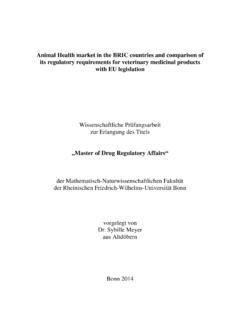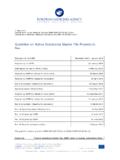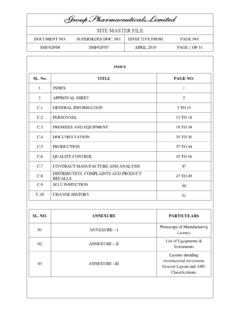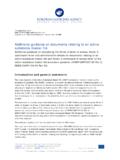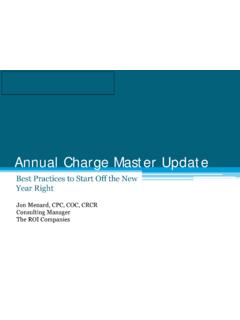Transcription of Regulatory Strategy for the Development of Known …
1 Regulatory Strategy for the Development of Known Drugs in New Therapeutic Areas Wissenschaftliche Pr fungsarbeit zur Erlangung des Titels master of drug Regulatory Affairs der Mathematisch-Naturwissenschaftlichen Fakult t der Rheinischen Friedrich-Wilhelms-Universit t Bonn vorgelegt von Dr. Janni Papakrivos aus Siegen Bonn, 2011 Betreuer und 1. Josef Hofer Zweiter Ambrosius, RA DGRA master Thesis 1 Table of Contents Table of List of 1 2 Legal Framework in the and Provisions of the Food, drug , and Cosmetic Act and the Code of Federal Regulations9 New drug Biologics License Requirement for Pediatric Exclusivity and Incentives Granted by the FDA for Drugs, Pediatric Studies and Orphans Approved under the Provisions of Section 505(b)(2) of the FD&C New drug Applications Submitted under Section 505(b)(2) of the FD&C Pediatric Development Orphan Provisions of Directive 2001/83/EC (as amended), the Pediatric Regulation EC/1901/2006 (as amended)
2 And Regulation EC/726 Marketing Authorization Applications for Marketing Authorization Applications for Requirement for Pediatric Exclusivity and Incentives Granted by the European Commission for Drugs, Pediatric Studies and Marketing Authorization Applications filed under the Provisions of Articles 6 and 10(5) of Directive 2001/83/EC (as amended)..19 Pediatric Development Orphan DGRA master Thesis 2 3 Intellectual and Commercial Property Basic Patent Term : drug Price Competition and Patent Term Restoration Act of EU: Supplementary Protection Freedom to 4 Prospective Health Technology General Preliminary Risk Benefit Continuous Technology 5 Drugs Repurposed for New Indications: Analysis of and EU US: Drugs@FDA EU: MRI Product Index 6 Appendix FDA Guidance for Industry: Applications Covered by Section 505(b)(2).
3 45 Appendix Guidance on a new therapeutic indication for a well-established Appendix Proposal for a Practical early Appendix Overview of Regulatory Strategy for the Repurposing of DGRA master Thesis 3 Part 1: Decision Part 2: Regulatory DGRA master Thesis 4 List of Abbreviations Deficit / Hyperactivity Disorder New drug Application License Application Pharmaceuticals for Children Act of Federal Regulations for Medicinal Products for Human Use Time Technology Assessment Medicines Agency FD&C , Drugs, and Cosmetics Act of Information Hormone Technology Assessment Screening Authorization Application Authorization Holder Marketing Authorization Application Sclerosis Available or Not Applicable drug Application Institutes of Health Molecular Entity Non-proprietary not conducted by or for the applicant and for which the applicant has not obtained a right of reference or use from the person by or for whom the investigations were conducted Pharmaceutical Collection Productivity Assessment Report Health Service Act Investigation Plan Research Equity Act Term Extension of Technical Success Use Marketing Authorization DGRA master Thesis 5 Benefit Assessment Benefit Balance Listed drug of Product Characteristics Protection Certificate
4 Product Profile Medical Need States Code In Process DGRA master Thesis 6 1 Introduction Over the past 10 years, the business model of the pharmaceutical industry has been challenged by increased Regulatory scrutiny due to serious concerns about the industry s transparency and ,2 As a result, the industry s price/earnings ratio has decreased below that of the S&P 500 index and has remained shallow, as have share prices for the past 7 Secondly, the industry has also been put to much pressure by generics and increasing health care budget constraints. In the , generics account for 70% of all In Europe, a fourth hurdle has been introduced in key countries where, after approval, new drugs are evaluated for their cost/benefit balance compared to existing therapies by such institutes as IQWIG (Institut f r Qualit t und Wirtschaftlichkeit im Gesundheitswesen)
5 In Furthermore, the pharmaceutical industry is being confronted with decreased R&D productivity and a dramatic loss of annual sales due to important patent expirations between 2010 and 2014, which has been forecast to be $113 billion, and for which each dollar lost is predicted to be replaced by only 26 cents with new product Indeed, experienced observers and industry analysts have even gone so far as to predict the industry s downfall in light of this unprecedented combination of adverse With the current average capitalized cost of $ billion and the average time of years for the Development of a first-in-class NME (New Molecular Entity) it is clear that R&D productivity has to improve dramatically to counteract the detrimental trends delineated R&D productivity is the relationship between the value of a new drug (commercial and medical) and the investments required to develop this drug .
6 Incorporating the key elements work in process (WIP), probability of technical success (PTS), value (V) in the nominator and cycle time (CT) and investment costs C in the denominator, R&D productivity (P) can be described as CTxCWIPxPTSxVP= in adaptation of the pharmaceutical value Increasing WIP, PTS or V of a new medicine will increase R&D productivity while increasing CT or C will decrease it and vice versa. With a view to the main phases of drug Development , High-Throughput Screening (HTS), hit-to-lead, preclinical and clinical, the clinical phases II and III have proven to be the most challenging as in these phases drugs often fail due to lack of efficacy or low safety margins (62% attrition rate in phase II and 45% in phase III).12 The combined success rate of phase III and approval has even fallen to 50% in recent Interestingly, these failures DGRA master Thesis 7 could generally be avoided if more time was spent on target validation and proof-of-concept studies using appropriate animal models and human volunteers in phase I and II, rather than prematurely advancing into phase III.
7 In fact, as Steven Paul et al. point out, phase III clinical trials should only fail because of unexpected adverse drug reactions and not because of poor portfolio management and short-term business In addition to these introductory considerations, strategies beyond the classic understanding of innovative drug Development ( the Development of NME s working through new mechanisms of action) exist that have proven to reduce Development costs and risks. They have worked without having to substantially increase WIP to compensate for the risky, cost- and time-intensive endeavor of creating first-in-class NME s. Most notably, the me too approach to develop modified NME s acting on proven targets, for which approved yet similar drugs exist, has been widely used. This approach effectively increases R&D productivity through increasing WIP, PTS, V and decreasing CT and C, as AstraZeneca s Nexium has powerfully demonstrated to name but one example.
8 The FDA approved Nexium in 2001 after patent protection expired for Nexium s predecessor Prilosec. While Prilosec was a racemic mixture of the drug substance, Nexium only contained the L-isomer effectively extending patent protection while offering no convincingly proven additional As me-too drugs have often shown little benefit over existing therapies, this approach towards boosting R&D productivity has been the subject of extensive ,15 In times of limited public health budgets, policy makers and healthcare payers are no longer willing to reimburse the pharmaceutical industry for medicines that show little benefit over existing and more cost-effective therapies. As a result, today s industry is facing the extraordinary challenge to meet the demands from both Regulatory agencies and third party A more sustainable approach to increase R&D productivity is by repurposing approved or once approved drugs for new therapies.
9 The novelty and cost effectiveness of this approach become immediately obvious when a qualified drug with a well- Known safety profile is discovered to be effective in new therapeutic areas. The most famous example is probably Thalidomide, which was used as a sedative and as a treatment for morning sickness during pregnancy in the 1950 s. Creating severe birth defects, it was withdrawn and decades later reapproved by the FDA for the treatment of leprosy in 1998 and multiple myeloma in ,18 As such, Thalidomide has served as an inspiring example of improving R&D productivity through finding new uses for old drugs. A second, less famous albeit not less creative example is Bimatroprost, which is a prostaglandin analogue originally approved for the reduction of intraocular pressure by the FDA in 2001.
10 Growth of eyelashes is a common side effect for this treatment so it was not surprising when a new NDA for this cosmetic indication was approved by the FDA in The advantage of using established drugs is DGRA master Thesis 8 Fig. 1 List of pharmaceuticals implemented in the NBC database (from ) obvious. They have been found to be safe and efficacious in their original indication, they usually have beneficial pharmacokinetic properties and in cases where a large human safety database exists they can enter human testing sooner than first-in-class NME s. Developing approved drugs for new indications therefore increases PTS and decreases CT and C, resulting in the substantial improvement of P. One could argue that V is less for repurposing Known drugs when compared to the creation of a first-in-class NME as follow-up developers cannot file patent applications claiming the molecule, and exclusivity terms are often shorter, too.









